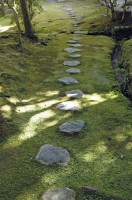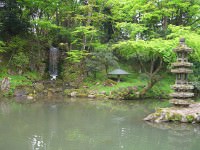
Waterfalls
Waterfalls are used to indicate where water enters a pond, to highlight a scene or to provide a focus. The decorative use of rocks, another important element of Japanese gardening, can be found in both pond and dry landscape gardens. Rocks are often used to help create waterfalls. The artful arrangements of upright stones may produce a dry tableau that resembles a waterfall (karetaki), or water may be forced over rocks to create the real thing. Stone bridges, white sand and pebbles are often placed in front of the dry stone waterfalls to symbolize a running stream. Garden waterfalls can take various forms: straight plunges from on high, two or three-stepped cascades or streams rushing over rock beds. Water was revered as a purifying, life-giving form in ancient Japan. Mountain waterfalls were seen as the highest expression of purity and energy, and thus as spiritual entities. A waterfall in a garden can evoke the same feelings of otherworldly strength. Some waterfalls are designed to model the belief that after swimming up the waterfall, a carp will turn into a dragon.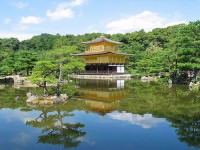
Ponds
Ponds were created in a variety of shapes. Geometrical forms such as rectangles and circles were usually avoided, except in smaller, domestic gardens. The pond should look natural with an irregular shoreline. Rocks were often used to create a rugged coastline or pebbly beach. Whenever possible, ponds were fed by natural streams, springs, waterfalls, or by water that was piped in.Peninsulas
Ponds in Japanese gardens often symbolize the ocean, and accordingly many gardens feature manmade peninsulas. It may be difficult to build an artificial island in the center of small garden ponds, so peninsulas were constructed instead. A peninsula adds a refined touch to a pond garden and makes it look larger than it really is. It can also add harmony and balance to a dry landscape garden, as when a peninsula of moss is set beside an ocean of white sand.Rocks
Rocks can be classified into three types: suisei-gan (sedimentary rocks), kasei-gan (igneous rocks) and hensei-gan (metamorphic rocks). Sedimentary rocks are usually smooth and round, and therefore are best suited for edges of ponds and stepping stones. Igneous rocks are usually rough in shape and texture, and are normally used for stepping stones, or to provide a highlight, such as a mountain. Because metamorphic rocks are very hard, they are often used around waterfalls and streams. Cut rocks (kiriishi) have become popular in modern times. Because they are often soft and easy to handle, sedimentary rocks are usually used for this purpose. Cut rocks are used for bridges, water basins and lanterns.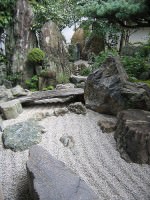
Rock Arrangements Symbolizing Eternal Life (Horai-iwagumi)
According to Shinsen thought, a mythical philosophy taught in ancient China, there is a land in the eastern ocean known as Horai where mountain hermits live in accordance with a philosophy of eternal life. Buddism propagated this belief and with the spread of Buddhism in Japan, dry landscapes or pond gardens with islands became increasingly popular as a symbol of popular longing for this mythical paradise.Islands (Naka-jima)
Naka-jima, or islands in garden ponds symbolize islands in the ocean. Adding an island to a pond makes the landscape look more elegant and natural. Islands can also play an important role if the designer wishes to prevent the visitor from seeing the entire pond, another example of “hide-and-reveal”. Naka-jima can be regarded as another aspect of the Shinsen thinking from ancient China, which proposed three mythical island utopias; Horai , Tsuru (Crane) and Kame (Turtle). Cranes and turtles are regarded as long lived creatures in Japanese culture, making them popular symbols of longevity in Japan. Islands vary considerably in size, depending on their role in the overall composition, and the size of the pond. Some islands are large enough to contain a hill with several trees, whereas some are only large enough for one or two rocks.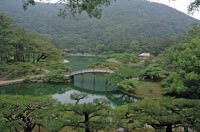
Bridges
Bridges are important elements of Japanese garden design, not only for pond gardens, but for dry landscape gardens as well. Bridges may be made of wood, stone, earth, copper or many other materials, and their design is equally varied. A bridge may be a simple wooden span or one with handrails or a roof. Some bridges are flat, while others are curved or sharply arched. The type of garden often determines the bridge architecture. Steeply arched bridges in paradise gardens, for example, symbolize the desire of garden designers to span the ocean separating paradise.